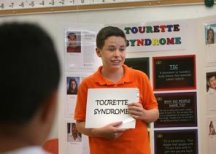Symptoms of Tourette's Syndrome:
Eyes/face/mouth: blinking, eye rolling, facial twitching, grimacing, head turning, jerking chin, snapping jaw, clenching jaw, pushing jaw, spitting, teeth grinding, tongue protrusion
Words/sounds: coprolalia/swearing, echolalia, grunting, humming, laughing, screaming, shrieking, snorting, squeals, speech arrest
Limb/trunk movements: echopraxia/mimicry, flailing arms/flapping arms, fingers touch lips, hand goes to mouth, hand clapping, hand rubbing, head nodding, head thrusting backward, arching head & back, jumping, kicking, rocking, stamping, throwing self on floors/walls, twirling/rotation
self-injurious & aggressive movements: head thrust back/extending neck, head thrust forward/neck flexion, head banging, hitting self, picking own skin, scratching self, self-mutilation, slapping chest, tongue biting, aggression, hitting others
autonomic changes: crying, drooling, face turns blue, blowing air, whistling, great difficulty breathing/gasping, noisy breathing/hyperventilation, ictal urinary, incontinence/enuresis
other: temporarily suppress movements, unsuccessful at suppressing, pattern of involuntary movement changes over time, epigastric or umbilical sensation, feeling weird, feel nervous right before episode, tingling sensations
Areas of the Brain Involved:
-frontal lobe(s)
-middle and inferior portions of the frontal lobe bilaterally
-coprolalia correlated with hypometabolism in the left parasylvian region near the speech area in the frontal lobes
-repetitive utterances - the midbrain and diencephalon
-a midsagittal cross-sectional head area - the overall length of the corpus callosum was reduced in TS patients - the corpus callosum were less rounded than those of normal controls
-basal ganglia -a significant difference was found for measures of symmetry in the putamen and lenticular region
-significant differences for the volume of the left globus pallidus and for lenticular asymmetry were also found
-ventrical dilation
-prominent sylvian fissures or cortical sulci
-enlarged occipital horns of the lateral ventricles bilaterally
-large porencephalic cyst in right hemisphere involving right basal ganglia
-a small arachnoid cyst in the occipital region
-slight cortical atrophy
Neurochemical Systems Involved:
-lower serotonin (5-HT) and lower glutamate - three major areas of subthalamic nucleus
-major metabolite of serotonin
-5-hydroxyindoleacetic acid was abnormally low
-dopaminergic activity - low
-excessive dopamine




